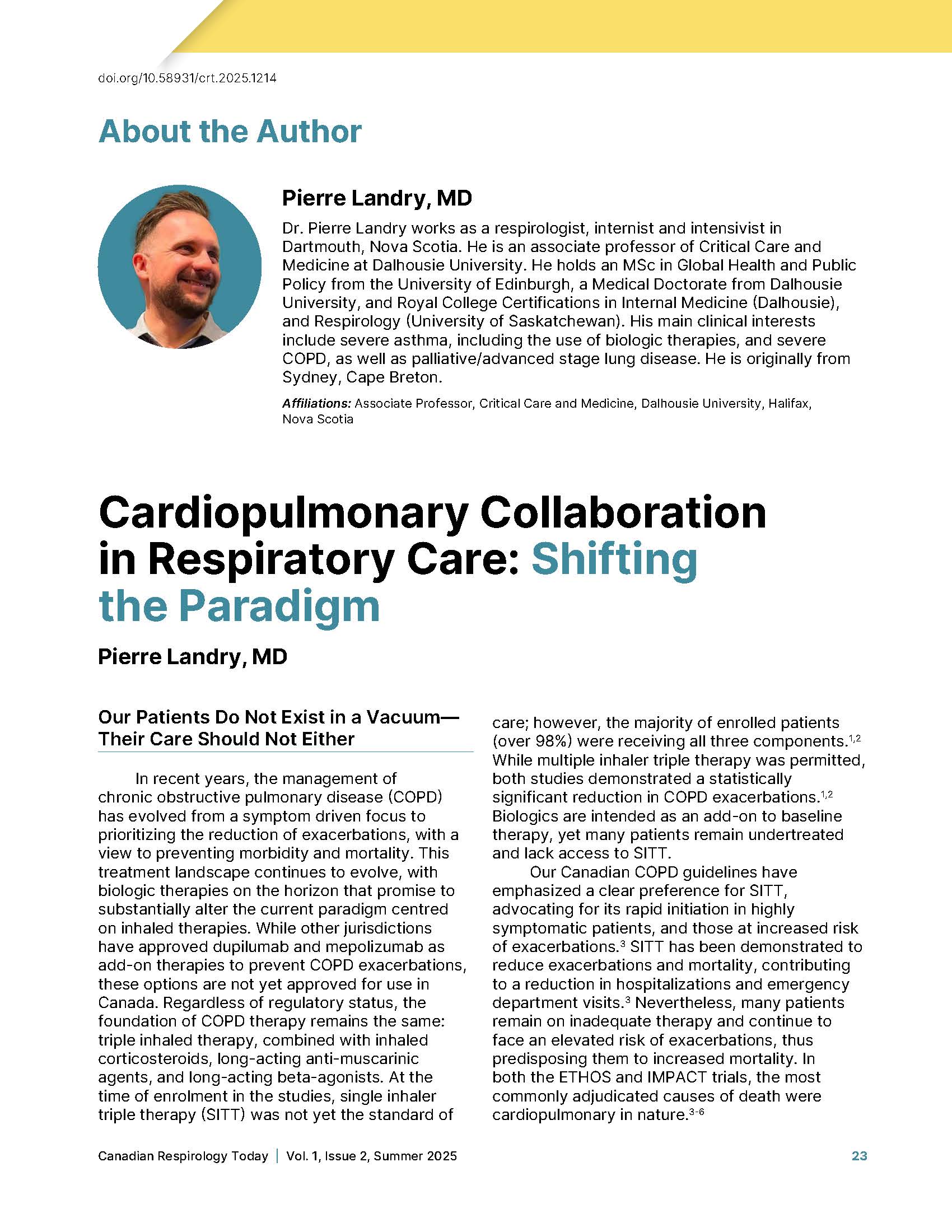Cardiopulmonary Collaboration in Respiratory Care: Shifting the Paradigm
DOI:
https://doi.org/10.58931/crt.2025.1214Abstract
In recent years, the management of chronic obstructive pulmonary disease (COPD) has evolved from a symptom driven focus to prioritizing the reduction of exacerbations, with a view to preventing morbidity and mortality. This treatment landscape continues to evolve, with biologic therapies on the horizon that promise to substantially alter the current paradigm centred on inhaled therapies. While other jurisdictions have approved dupilumab and mepolizumab as add-on therapies to prevent COPD exacerbations, these options are not yet approved for use in Canada. Regardless of regulatory status, the foundation of COPD therapy remains the same: triple inhaled therapy, combined with inhaled corticosteroids, long-acting anti-muscarinic agents, and long‑acting beta-agonists. At the time of enrolment in the studies, single inhaler triple therapy (SITT) was not yet the standard of care; however, the majority of enrolled patients (over 98%) were receiving all three components. While multiple inhaler triple therapy was permitted, both studies demonstrated a statistically significant reduction in COPD exacerbations. Biologics are intended as an add-on to baseline therapy, yet many patients remain undertreated and lack access to SITT.
Our Canadian COPD guidelines have emphasized a clear preference for SITT, advocating for its rapid initiation in highly symptomatic patients, and those at increased risk of exacerbations. SITT has been demonstrated to reduce exacerbations and mortality, contributing to a reduction in hospitalizations and emergency department visits. Nevertheless, many patients remain on inadequate therapy and continue to face an elevated risk of exacerbations, thus predisposing them to increased mortality. In both the ETHOS and IMPACT trials, the most commonly adjudicated causes of death were cardiopulmonary in nature.
Single inhaler therapy has been shown to be safe, effective, and economical. The number needed to treat (NNT) to prevent a moderate or severe COPD exacerbation is 1:4, while the number needed to harm (NNH) for pneumonia is 1:33. Despite this favourable profile, there appears to be hesitancy regarding initiation of therapy. Whether this stems from regulatory barriers regarding access to medication, hesitancies based on risk perception pertaining to pneumonia or other adverse events, or gaps in knowledge, this is a situation which deserves urgent attention, in light of the simplicity and effectiveness of this intervention.
References
Bhatt SP, Rabe KF, Hanania NA, Vogelmeier CF, Cole J, Bafadhel M, et al. Dupilumab for COPD with type 2 inflammation indicated by eosinophil counts. N Engl J Med. 2023;389(3):205-214. doi:10.1056/NEJMoa2303951
Sciurba FC, Criner GJ, Christenson SA, Martinez FJ, Papi A, Roche N, et al. Mepolizumab to prevent exacerbations of COPD with an eosinophilic phenotype. N Engl J Med. 2025;392(17):1710-1720. doi:10.1056/NEJMoa2413181
Bourbeau J, Bhutani M, Hernández P, Aaron SD, Beauchesne MF, Kermelly SB, et al. 2023 Canadian Thoracic Society Guideline on Pharmacotherapy in Patients with Stable COPD. Chest. 2023;164(5):1159-1183. doi:10.1016/j.chest.2023.08.014
Rabe KF, Martinez FJ, Ferguson GT, Wang C, Singh D, Wedzicha JA, et al. Triple inhaled therapy at two glucocorticoid doses in moderate-to-very-severe COPD. N Engl J Med. 2020;383(1):35-48. doi:10.1056/NEJMoa1916046
Lipson DA, Barnhart F, Brealey N, Brooks J, Criner GJ, Day NC, et al. Once-daily single-inhaler triple versus dual therapy in patients with COPD. N Engl J Med. 2018;378(18):1671-1680. doi:10.1056/NEJMoa1713901
Stolz D, Hermansson E, Ouwens M, Singh B, Sharma A, Jackson D, et al. Mortality risk reduction with budesonide/glycopyrrolate/formoterol fumarate versus fluticasone furoate/umeclidinium/vilanterol in COPD: a matching-adjusted indirect comparison based on ETHOS and IMPACT. Curr Med Res Opin. 2023;39(10):1395-1405. doi:10.1080/03007995.2023.2247969
Singh D, Han MK, Hawkins NM, Hurst JR, Kocks H, Skolnik N, et al. Implications of cardiopulmonary risk for the management of COPD: a narrative review. Adv Ther. 2024;41(6):2151-2167. doi:10.1007/s12325-024-02855-4
Siu DCH, Gafni-Lachter L. Addressing barriers to chronic obstructive pulmonary disease (COPD) care: Three innovative evidence-based approaches: A review. International Journal of Chronic Obstructive Pulmonary Disease. Int J Chron Obstruct Pulmon Dis. 2024;19:331-341. Published 2024 Feb 1. doi:10.2147/COPD.S426050
Canadian Institute for Health Information. CIHI Snapshot April 2019 [Internet]. 2019 [cited 2025 Aug 24]. Available from: https://www.cihi.ca/sites/default/files/document/dad-hmdb-childbirth-quick-stats-2017-2018-snapshot-en-web.pdf
Canadian Institute for Health Information. COPD: A focus on high users — Infographic | CIHI [Internet]. 2025 [cited 2025 Sep 04]. Available from: https://www.cihi.ca/en/copd-a-focus-on-high-users-infographic
Risebrough NA, Mursleen S, Kerigo Ndirangu, Shah D, Martin A, Schroeder M, et al. The long-term clinical and economic benefits of treating advanced COPD patients with single-inhaler triple therapy in Quebec, Canada – the IMPACT trial. Respir Med. 2024;231:107694. doi:10.1016/j.rmed.2024.107694
Farooqi MAM, Ma J, Ali MU, Zaman M, Huang J, Xie Y, et al. Prevalence and burden of COPD misclassification in the Canadian Longitudinal Study on Aging (CLSA). BMJ Open Respir Res. 2022;9(1):e001156. doi:10.1136/bmjresp-2021-001156
Blazer AJ, Stanbrook MB. How can Canada’s health systems improve care for people with chronic obstructive pulmonary disease? CMAJ 2023;195(35):E1182-E1183. doi:10.1503/cmaj.230998
Tkacz J, Evans K, Touchette DR, Portillo E, Strange C, Staresinic AG, et al. PRIMUS – prompt initiation of maintenance therapy in the us: a real-world analysis of clinical and economic outcomes among patients initiating triple therapy following a COPD exacerbation. Int J Chron Obstruct Pulmon Dis. 2022;17:329-342. Published 2022 Feb 10. doi:10.2147/COPD.S347735
Appendix III -Criteria for Coverage of Exception Status Drugs [Internet]. 2025 [cited 2025 Sep 04]. Available from: https://novascotia.ca/dhw/pharmacare/documents/Criteria-for-Exception-Status-Coverage.pdf


